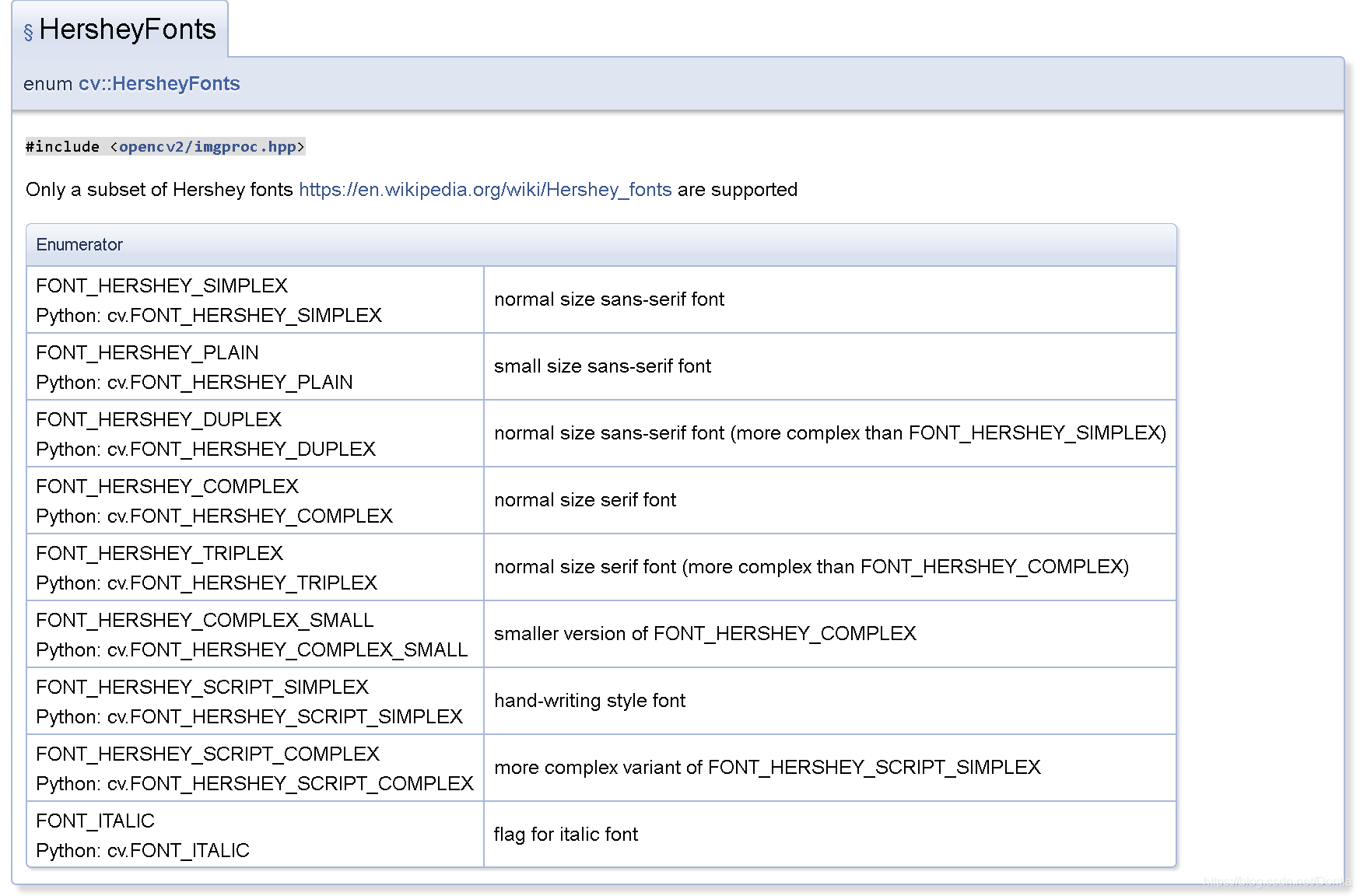参考文章1:python如何在图片上添加文字(中文和英文)Python在图片上添加文字的两种方法:OpenCV和PIL
参考文章2:python之------如何在图片上面添加文字(多种类型的文字)【PIL】
参考文章4:python-OpenCV之在图片上添加文字(cv.putText())
putText函数doc
opencv版本:4.1.0(不同版本Doc也许不同)
def putText(img, text, org, fontFace, fontScale, color, thickness=None, lineType=None, bottomLeftOrigin=None): # real signature unknown; restored from __doc__
"""
putText(img, text, org, fontFace, fontScale, color[, thickness[, lineType[, bottomLeftOrigin]]]) -> img
. @brief Draws a text string. 绘制文本字符串。
.
. The function cv::putText renders the specified text string in the image. Symbols that cannot be rendered
. using the specified font are replaced by question marks. See #getTextSize for a text rendering code
. example.
·
函数cv :: putText在图像中呈现指定的文本字符串。
无法使用指定字体呈现的符号将替换为问号。 有关文本渲染代码示例,请参见#getTextSize。
.
. @param img Image. 图片。
. @param text Text string to be drawn. 要绘制的文本字符串。
. @param org Bottom-left corner of the text string in the image. 图像中文本字符串的左下角。
. @param fontFace Font type, see #HersheyFonts. 字体类型,请参见#HersheyFonts。
. @param fontScale Font scale factor that is multiplied by the font-specific base size.
字体比例因子乘以特定于字体的基本大小。
. @param color Text color. 文字颜色。
. @param thickness Thickness of the lines used to draw a text. 用于绘制文本的线条的粗细。
. @param lineType Line type. See #LineTypes 线型。 请参阅#LineTypes
. @param bottomLeftOrigin When true, the image data origin is at the bottom-left corner. Otherwise, it is at the top-left corner.
如果为true,则图像数据原点位于左下角。 否则,它位于左上角。
"""
pass
Doc中所指#HersheyFonts:链接


Doc中所指#LineType:链接


示例代码
功能
将上上级imgs文件夹内的2000张图片全部打上标记,显示其模糊程度值(越小越模糊)(用于展示用)
code
# -*- encoding: utf-8 -*-
"""
@File : judge_the_picture_blur.py
@Time : 2019/10/25 8:52
@Author : Dontla
@Email : sxana@qq.com
@Software: PyCharm
"""
import cv2
import os
# 返回指定路径图像的拉普拉斯算子边缘模糊程度值
def getImageVar(img_path):
image = cv2.imread(img_path)
img2gray = cv2.cvtColor(image, cv2.COLOR_BGR2GRAY)
imageVar = cv2.Laplacian(img2gray, cv2.CV_64F).var()
return imageVar
# 返回给定文件夹下所有图片的路径列表
def listFolderImgPath(folder_img_path):
img_path_list = []
for filename in os.listdir(folder_img_path):
filepath = os.path.join(folder_img_path, filename)
img_path_list.append(filepath)
return img_path_list
# 给单张图片添加文字(图片路径,文字)
def writeText(img_path, text):
# 加载背景图片
# img的类型是np.ndarray数组
img = cv2.imread(img_path)
# 在图片上添加文字信息
# 颜色参数值可用颜色拾取器获取((255,255,255)为纯白色)
# 最后一个参数bottomLeftOrigin如果设置为True,那么添加的文字是上下颠倒的
composite_img = cv2.putText(img, text, (100, 680), cv2.FONT_HERSHEY_SIMPLEX,
2.0, (255, 255, 255), 5, cv2.LINE_AA, False)
cv2.imwrite(img_path, composite_img)
# 文件夹路径
folder_img_path = '../../imgs/'
# 图片路径
img_path = '../../imgs/f_cotton-g_top (813).jpg'
# print(getImageVar(img_path))
# print(listFolderImgPath(folder_img_path))
# 获取图片路径列表
img_path_list = listFolderImgPath(folder_img_path)
# 循环处理每张图片
for img_path in img_path_list:
# 获取该张图片模糊值
imageVar = getImageVar(img_path)
# 创建需写入文字信息
text = 'The fuzzy is: {:.2f}'.format(imageVar)
# 将文字写入图片
writeText(img_path, text)
# img = cv2.imread(img_path)
# cv2.namedWindow('image', cv2.WINDOW_AUTOSIZE)
# cv2.imshow('image', img)
# cv2.waitKey(1)
最终效果


























 1390
1390











 被折叠的 条评论
为什么被折叠?
被折叠的 条评论
为什么被折叠?










